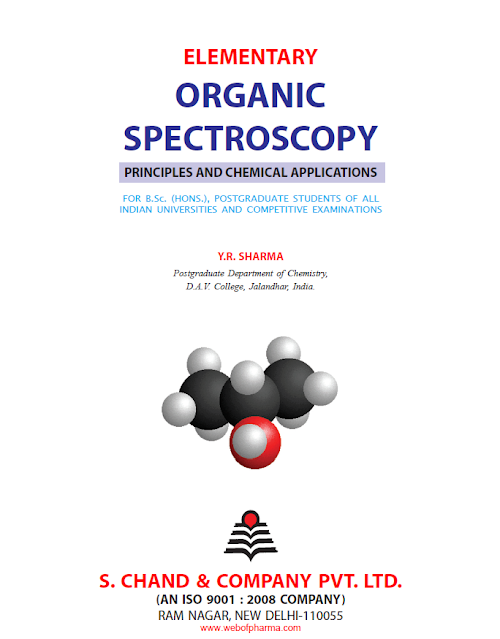Elementary Organic Spectroscopy Principles And Chemical Applications
The warm reception accorded to the fourth edition of Elementary Organic Spectroscopy and its subsequent reprints has provided me a great deal of encouragement to present the fourth edition of this book. The subject-matter presented in the book is sufficiently comprehensive and the knowledge gained through it will make easy to identify an unknown compound. The massive scope of the subject dictates that all possible visual assistance be available to the students. This has been done by presenting a large number of spectral diagrams which have been added in this edition. Their interpretation serve to reinforce as well as assist the students in learning the subject. This attempt also helps the students to develop an intutive feel in using spectroscopy to solve structural problems. The main features of the present edition are :
- Multichoice questions are added in each chapter. Some numerical problems are also included where required.
- A chapter on ‘Raman Spectroscopy’ has been added to meet the demand of a large number of students and teachers. This technique forms a part of curriculum in most of the universities and is dealt here in reasonable detail.
- Each chapter in the text is made more elaborate by induction of suitable material in the form of applications, numerical problems and explanation of new spectra. Important features for each technique, Short Question with Answers, Important problems (Solved) form special features of the fifth edition.
- A number of problems have been given for the students to check their competence.
- Extensive summarises have been placed at the end of each shapter in order to review each topic and highlight the main points.
- Every attempt is made to retain the comprehensive character of the text so as to ensure that it continues to be one volume text for the students studying Organic Chemistry at the Graduate and Postgraduate levels.
- A large number of new figures have been added in the text and all old figures have been redesigned.
- In the ultra-violet spectroscopy, Polycyclic hydrocarbons and their spectra have been discussed and proton nuclear magnetic resonance spectra of carbocations have been given.
I express my gratitude to my colleagues and friends who gave useful suggestions and took keen interest in the revision of the book. Thanks are due to my wife, Mrs. Saroj Sharma for the secretarial assistance which she rendered during the revision of the book. I will welcome suggestions and healthy criticism of the subject-matter and style for the further improvement of this book.
Methods based on relationships between structural features and physical properties are now making an ever increasing contribution to organic chemistry, not only in the elucidation of structure, but also in analytical and preoperative work. The advantages of these methods are obvious particularly in the study of tautomeric, conformation and other equilibrium. It is, therefore, not surprising that the growing availability of physical methods has altered both the scope and pace of organic chemistry. Many recent successes in the determination of the structures of complex natural products would have remained out of reach without them and their contribution in widening our understanding of the reactivity of organic compounds can hardly be overestimated. This appreciation of the power of these methods prompted the author to venture on this elementary introduction to the absorption techniques in organic spectroscopy.
The book is written specifically for the undergraduate and it is hoped, that it will render valuable help to the postgraduate students as well. The primary aim of this introductory book is to provide a broad survey of the methods and special care is taken on the application of these methods on selected representative molecules which will give clear insight into the subject. The text will be found to be graded from known to unknown and from very simple to difficult problems. The worked examples and unsolved problems with their answers in the index have been very carefully selected to cover as many as possible of the important aspects of the subject matter in the space available. It is hoped that the book will be warmly received and will prove beneficial to the students and the teachers alike.
I simply fumble for words to express my heavy debt of gratitude towards Dr. O.P. Vig, Professor and Head, Department of Chemistry, Punjab University, Chandigarh, who was gracious enough for sparing time out of his busy schedule to go through the book and then writing foreword to it. It has, of course, enhanced its value and prestige.
I express my gratitude to my colleagues and friends, who, by their encouragement, interest and advice helped me to write this book. My sincere thanks are particularly due to Dr. I.R. Trehan, Reader in Organic Chemistry, Punjab University, Chandigarh, who took all the pains in reading the whole of the manuscript and gave valuable suggestions. Thanks are also due to Sh. G.D. Sharma, Head of the Post-Graduated Deptt. of Chemistry, D.A.V. College, Jalandhar, Dr. K.D. Sharma, lecturer in Chemistry, Govt. College, Hoshiarpur, and Sh. M.L. Sehgal, lecturer in Chemistry, D.A.V. College, Jalandhar, for making valuable criticisms.
I am grateful to Sh. Shyam Lal Gupta, Managing Director, S. Chand and Company Ltd., New Delhi and Sh. S.K. Moudgil, Branch Manager, Jalandhar, for the interest they took during the preparation of the book.
Finally I thanks my wife, Mrs. Saroj Sharma who inspired me during the preparation of the text. I will welcome any criticism of the subject matter and style for further improvement of this new enterprise.





.webp)





%20Web%20of%20pharma%20.webp)


.webp)
